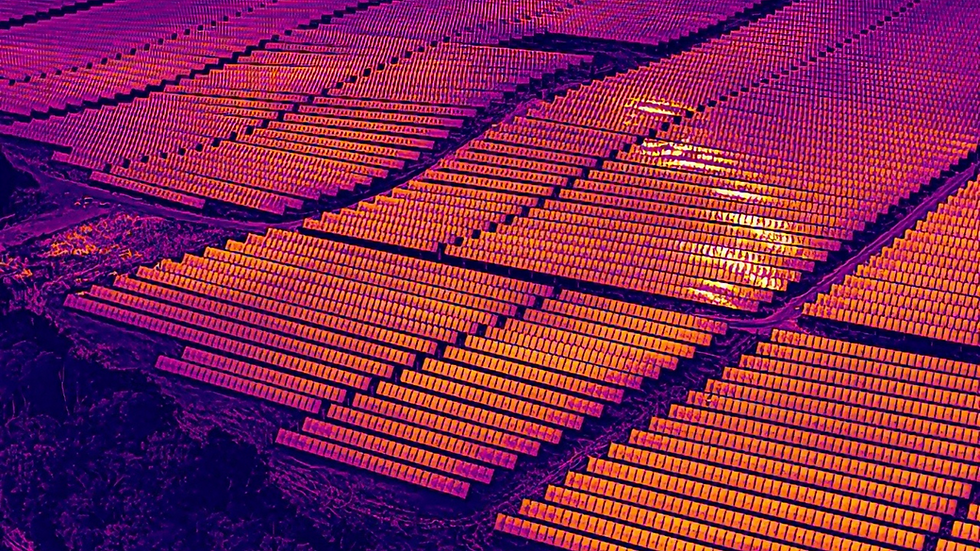What Drone Thermal Cameras Can Detect in a Solar Inspection
- Hannah Smith

- Sep 30
- 4 min read
Updated: Oct 8

Solar panel inspections are a crucial aspect of solar maintenance, ensuring the efficiency, safety, and longevity of any solar energy system. An effective tool for performing solar panel inspections is thermal imaging, which in recent years has been revolutionized by drone technology. Drones, equipped with infrared thermal cameras and complex mapping tools, can quickly and effectively detect temperature variations that are not visible to the naked eye. These temperature variations are an indicator of various safety and production concerns that need to be addressed and repaired.
While there is no question that thermal drone inspections are an important and effective aspect of solar maintenance, some may wonder what a thermal drone camera can detect during a thermal flyover.
Although the details and comprehensiveness of a thermal report will be dependent on the type of drone, mapping software, and drone contractor used, here are some of the safety and production issues that may be detected during a drone thermal inspection:
Shading and Overgrown Vegetation
Shading can be caused by buildings, equipment, trees, or overgrown vegetation (tall grass, weeds, or bushes). It is best to address any shaded spots as they will significantly impact production.
Hotspots
Hotspots are localized spots on panels that are significantly hotter and need to be addressed, as they are signs of microcracks, soiling, cell damage, manufacturing defects, etc. They are essential to address as they not only cause production issues but also pose a fire risk.
Faulty Diodes
Diodes allow current to bypass shaded or damaged cells, keeping the panel producing power and preventing hotspots. If this component is detected as faulty, there is a risk for hotspots to increase and become more severe.
Offline Combiner
In a thermal scan, if a combiner is offline (not carrying current), the associated array may actually appear “hotter”. This is because they are not under load and have no way for heat to dissipate, thus the higher temperature rating.
An offline combiner should be addressed immediately as it indicates that one section of the solar array is not producing or delivering power to the rest of the system. This is a sign of a fault or disconnection and is a serious issue for site performance.
Offline String
Strings can go offline due to an open circuit, blown fuse, or disconnection. When this happens, the modules in that string will appear hotter, similar to an offline combiner as the heat has nowhere to dissipate. This has local performance impact and sometimes even safety implications, depending on the cause.
Offline Inverter
Although the inverters are not scanned on a thermal flyover, just the array, an experienced technician can make the assumption that an inverter is offline based on the thermal findings. During a thermal scan, if an entire inverter’s array is showing a higher heat signature, it can mean that inverter is offline. An experienced technician compares thermal flight data to corresponding site plan sets to determine if issues found are affecting single modules, partial or entire strings, partial or entire combiners, or partial or entire inverters and can give more accurate data for their customers based on the findings in the thermal report.
Faulty Connections or Wiring
Faulty electrical connections often cause resistance, which leads to localized heat buildup. A thermal drone camera can detect these hot spots and, with this knowledge, can help a technician determine what is causing the faulty connection: Loose or corroded connectors, overheating fuse or breaker, damaged busbars, connector arcing, etc. These are serious concerns that need to be addressed and corrected quickly, as the buildup of heat can result in fires.
Performing a thermal drone inspection can uncover a large number of potential production and safety concerns. After a thermal scan is completed, it is best for a skilled solar technician to further investigate the detected heat anomalies on the report and perform further testing and/or replace faulty components. It is suggested that once a thermal inspection is completed, a repair plan is set in motion immediately, as most of the issues found on the report can get worse over time, causing serious implications to site safety and production guarantees. Catching these issues in a drone thermal inspection before they escalate will save time and money and improve the longevity of the solar investment.
In need of a thermal drone inspection?
Day Electric performs thermal drone inspection and repair services to owners, operators, and developers in the solar industry. Day Electric’s drone inspections are unique as they are performed by our in-house electricians, who have multiple years’ experience in commercial and utility solar. Thus, our pilots cannot only safely and accurately perform a drone inspection but also analyze the thermal report and create recommended actions and repairs based on the findings. We believe this is the benefit of working with Day Electric, as we always try to streamline our testing and repair services to better serve our customers.
For thermal drone inspection services on your next project under construction or in operation, reach out to Day Electric at info@dayelectricusa.com.










Comments